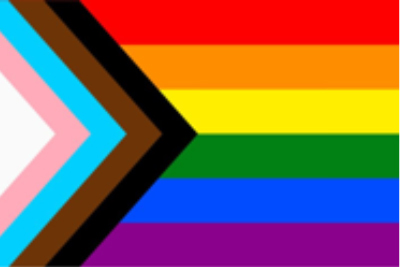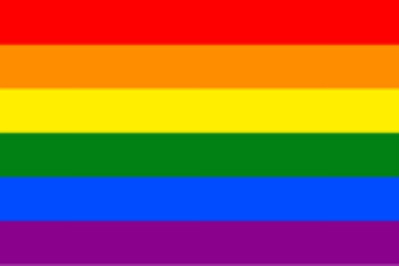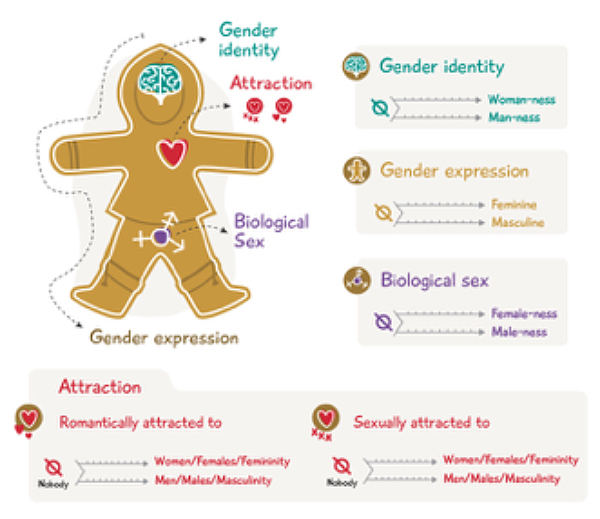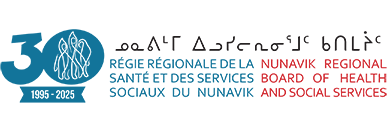Why do we celebrate Pride in Nunavik?
Sometimes we feel uncomfortable with new things and differences. It’s normal that it may seem scary at first, but just as we want people to be tolerant of us, it’s important to be tolerant of others in order to live in harmony. Whether we’re talking about personality or appearance, everyone is different and deserves to be respected and accepted as they are.
What is Pride?
Pride is being proud of who you are. It's about accepting yourself and others. No matter the age, ethnicity or sexual orientation. It's also about remembering those who fought before us for equal rights.
Historically, in New York City, on June 28, 1969 a police raid occurred at the Stonewall Inn, a gay club in Greenwich Village. This led to a riot by bar patrons, staff and neighborhood residents. More than six days of protests and clashes ensued. The protesters demanded the creation of places where LGBTQ+ people could live their lives openly and safely, without fear of arrest.
A year later, on the occasion of the commemoration of the Greenwich Village riots, thousands of LGBTQ+ protesters gathered in the streets of New York to demonstrate and remember the events. This is the origin of Pride. The 1969 riots were also the origin of the creation of many LGBTQ+ rights organizations.
Pride is an opportunity for the LGBTQ+ community to come together to celebrate the acceptance of sexual and gender diversity. Everyone is invited to participate to show their support for the cause.
What we see in the media about Pride can sometimes seem extravagant, but Pride is about more than just the parade, it's about supporting differences and being inclusive to all members of the community. It is first and foremost a message of tolerance and love.
What does the flag mean?


The rainbow flag is the symbol of LGBTQ+ Pride, representing diversity. It has evolved over time; the first version was created in San Francisco in 1978. It had eight bands of colours and each colour had a meaning: red for life, orange for comfort, yellow for sunshine, green for nature, blue for art and purple for spirituality.
Since 2018, the Progressive Pride flag has been seen more often. It’s more inclusive thanks to the white, pink and blue of the transgender flag, as well as the brown and black symbols of visible minorities.
Sex, sexual orientation and gender
What does LGBTQ+ mean?
Several acronyms are used to identify diversity. For example, LGBTQ+ refers to the lesbian, gay, bisexual, transgender, and queer communities. While 2SLGBTQIA includes two-spirited (2S), intersex (I), and asexual (A) people in addition to the communities listed above. Regardless of the acronym used, all diversity is always represented in the different names that exist with the ultimate goal of inclusion for all.
Some definitions:
Heterosexual: A person who is sexually attracted to individuals of the opposite sex. Heterosexuality is a sexual orientation.
Homosexual: A person who experiences sexual attraction to individuals of the same sex. Homosexuality is a sexual orientation.
Bisexual: A person who has sexual attraction to both men and women. Bisexuality is a sexual orientation.
Asexual: A person who has no sexual attraction to anyone. Asexuality is a sexual orientation.
Pansexual: A person who has a sexual attraction to another person's personality, regardless of gender or identity. Pansexuality is a sexual orientation.
Gay: A man who is attracted to other men. Sometimes the term "gay" is used as a word to generalize sexual orientation between people of the same sex (men and women).
Lesbian: A woman who is attracted to other women.
Transgender: A person whose gender identity does not correspond to the sex assigned at birth.
Non-binary: A person who does not identify as male or female. Or who identifies with both genders.
Queer: A person who does not identify with any category related to their sexual orientation and gender identity.
Two-spirited: In some Indigenous cultures, a two-spirited individual is one who possesses both male and female spirits.
Questioning: A person who is unsure of their sexual orientation and/or gender identity.
Intersex: A person who is born with both male and female sex characteristics or sex organs.
Ally: A non-LGBTQ+ person who supports LGBTQ+ causes and fights their injustices and inequalities.
What is identity?
Our identity is how we identify ourselves; it’s how we perceive who we are. Many things are part of our identity and make each of us unique. One part of our identity is our gender identity, which refers to the following things:
Sex assigned at birth: Doctors and midwives assign a sex to babies at birth. It’s mainly based on body parts such as reproductive organs, but it also includes hormone levels. The sex assigned at birth is usually female or male.
Sexual orientation: This is the emotional, romantic and sexual attraction a person feels towards others. It is the nature of physical and emotional attraction (desire). Sexual orientation is not a choice, it is something you feel, a desire based on physical attraction.
In short, it’s people you are physically and romantically attracted to.
Gender Identity: This is how we perceive ourselves; the deep sense that we are male or female, both, neither or somewhere along the gender spectrum. It can sometimes be consistent with the sex assigned at birth, but it can also be different.
In short, it’s what you feel you are.
Gender expression: This is the way a person openly expresses their gender. This can include behaviors and appearance, such as clothing choices, hairstyle, makeup, body language and voice. Gender expression changes over time with societal norms and the media, but everyone can choose to express the gender they want, regardless of their gender identity. For example: one can identify as female, but choose to have a masculine or non-binary gender expression.
In short, it’s how I express who I am and how I want the world to perceive me.

How can we contribute to a more tolerant and open Nunavik?
How to react to someone coming out.
Coming out is when an LGBTQ+ member speaks openly about their sexual orientation or gender identity. Coming out is a very personal thing. A person can choose to come out at any time and should never feel pressured to do so. It can take years before a person is ready to talk about their gender identity. Many people who decide to come out have thought long and hard about how they want to come out and the words they want to use.
Each coming out can provoke unexpected reactions and it can be quite difficult to do. Think of coming out experiences as a ladder; a person climbing a ladder will test each step as they go. The same is true of coming out. Each time a person comes out, it’s like a step on the ladder. If it goes well and is welcomed, the person will feel confident enough to continue climbing the ladder, but if one step does not go well (negative reaction), then it becomes harder to believe that the next steps will go well. That's why it's important to remember that our reactions to someone coming out are important. Here's how to react to someone coming out:
- Listen. Coming out is never easy. Let the person speak and accept the words they use. These words have often been carefully considered.
- Thank the person for trusting you. The person who decides to come out to you is making himself or herself very vulnerable.
- Show that you are open. Tell the person that you are available to talk, without being too demanding. If you feel uncomfortable, refer the person to someone who you think would be better able to help.
- Reassure them. The person who comes to you may need reassurance. They may be concerned about your reaction, so be sure to tell them that it's not a problem and that they shouldn't be ashamed of who they are.
- Avoid telling the person that you knew/suspected it. Before coming out, LGBTQ+ members sometimes go to great lengths to hide this part of their identity. Saying you knew can trigger unnecessary "who else knows?" anxiety.
- Respect their confidentiality. Do not talk about a person's coming-out or their sexuality. The person may not be ready to tell anyone else. They may be afraid of discrimination or backlash. Let them do it at their own pace.
- Make sure the person coming out is safe. LGBTQ+ members are at greater risk of bullying and other forms of violence. Make sure the person confiding in you does not fear for their safety. Help them if they need it.
How to be a good ally.
An ally is a non-LGBTQ+ person who supports and defends the rights of LGBTQ+ people. Anyone can be an ally. Allies are important, they show support for LGBTQ+ people and humans in general. Being an ally is like being a friend.
There are many ways to be an ally in the fight against discrimination:
1. Recognize and act
- Challenge your own assumptions about diversity
- Expressing discomfort with discriminatory actions directed at others is wrong
- Recognize that discrimination exists in our society
2. Get informed
- Research the historical origins of oppression
- Seek information on the current challenges faced by people who are discriminated against
- Surround yourself with people who are different from you
3. Educate others
- Talk to your family about the importance of diversity
- Share information, movies or stories related to diversity
- Encourage friends to include new people in their activities
4. Support and encourage
- Listen to the views of others during discussions
- Participate in activities that encourage inclusion
5. Initiate and prevent
- Organize activities that encourage diversity
- Express disagreement with rules that discriminate against others
- Propose solutions to discriminatory situations
Information and support resources
I Respect Myself (English / Inuktitut / French): www.irespectmyself.ca
Kamatsiaqtut (English / Inuktitut / French): www.nunavuthelpline.ca
Native Montreal (English / French): www.nativemontreal.com
Kids Help Phone (English / French): www.kidshelpphone.ca
Tel-jeunes (English / French): www.teljeunes.com
Interligne (English / French): www.interligne.co
LGBT+ Family Coalition (English/French): www.familleslgbt.org
